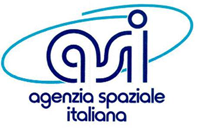About Milan
Milan is a dynamic, proactive and progressive city, with a strong competitive edge. Fashion, design, finance, and publishing are the driving forces behind the Milanese economy, along with chemicals, mechanical engineering, and advanced research. Nonetheless it is a very interesting and pleasant city, thanks to its famous art and culture masterpieces, renowned shopping opportunities, and wide offers of bar and restaurants. In the following we describe just a few of the highlights of this beautiful city, whereas a lot more are left to the IGARSS attendees to discover on their own.
The first place anyone who lives in Milan will take a first-time visitor is of course Piazza del Duomo, the geographical and historical centre of Milan. Construction started under Gian Galeazzo Visconti, most likely 1386, and continued until the 19th century. The Duomo itself is one of the world’s largest churches; its impressive interior reveals its vertical Gothic spirit. It contains numerous works of art, including the tomb of Gian Giacomo Medici by Leone Leoni (1563).
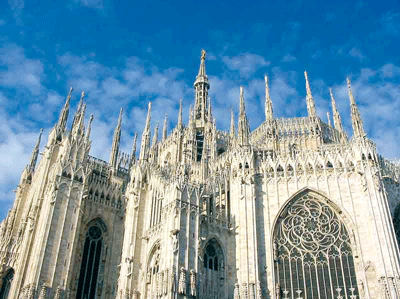
The Duomo of Milan
The basilica of San Lorenzo Maggiore is another highlight of Milan. Preceeded by an Imperial Roman colonnade, it is a truly striking sight. Its essential features are those of a late 17th century church, but as it was built incorporating a paleochristian building, it is considered the most important surviving testimony of Roman and paleochristian Milan. In its central interior, it is worth visiting the chapel of Sant’Aquilino with its 4th century mosaics.
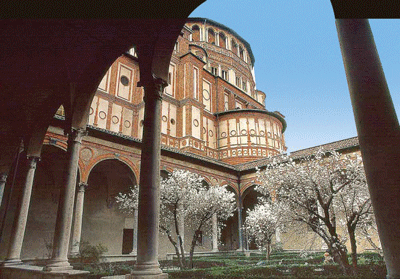
The basilica of San Lorenzo Maggiore
Another famous landmark of Milan, the basilica of Sant’Ambrogio was founded by Bishop Ambrose in 379 as a “basilica Martyrum” on the tombs of Saints Gervasius and Protasius; the bihop was himself buried here in 397. Its current Romanesque appearance is the result of thorough changes and reconstructions between the 9th and 12th centuries as well as modern restoration work. Before the basilica is the solemn foyer of Ansperto, concealing the façade from passersby on the street. Inside the church are a 10th century ciborium above the gold altar, a masterpiece of the Carolingian goldsmiths’ art, and the crypt. The apse is decorated with a big 6th to 8th century mosaic.
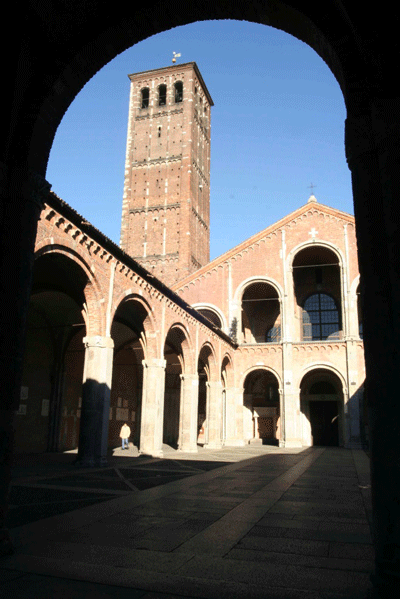
The basilica of Sant’Ambrogio
Santa Maria delle Grazie, a splendid example of Renaissance architecture, is best known for Leonardo da Vinci’s Last Supper, the Cenacolo di Leonardo, with an imposing Renaissance tribune added in 1492. In the oldest part of the church (in the Gothic style) are frescoes by Gaudenzio Ferrari and Marco d’Oggiono, as well as a monument to Ludovico il Moro. The 15th century “Madonna delle Grazie” in the left chapel of the tribune was much venerated during the plagues of the 16th and 17th century. In the chapel on the right was Titian’s “Crowning with thorns”, which the French took to Paris in the late 18th century, now in the Louvre.
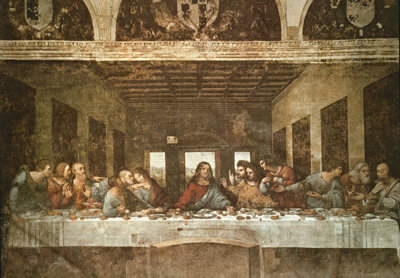
Leonardo’s “Last Supper” in Santa Maria delle Grazie
Besides its monuments, Milan is also well known for its stylish and lively areas. The Navigli, canals lined by narrow alleyways and traditional houses with communal balconies, and the city’s “green oases”, with their picnic, entertainment and sports areas, preserve the feel of yesteryear Milan. Although far from Italy’s great rivers and seas, Milan, like Venice, was for many centuries a navigable city due to an intricate system of canals that once crisscrossed the city. Back then, the city had a circular canal – the Cerchia dei Navigli – connected to three small ports: Santo Stefano (now Piazza Santo Stefano), San Marco (Piazza San Marco) and Sant’Eustorgio, which later became the Darsena di Porta Ticinese (Basin of Porta Ticinese). Connected to the Cerchia dei Navigli through the Conca dei Navigli, still visible today in the street of the same name, the Darsena’s waters flow in from the Naviglio Grande and then out again into the Naviglio Pavese (the two canals flow in opposite directions), thus creating a “water circuit” that for centuries constituted the city’s main means of provisioning and trade, through flat-bottomed barges drawn by horses (or men, when required) along the so-called Alzaie, or towpaths. Today, the first stretch of the Naviglio Grande – the oldest of the two navigable canals, dating back to the 13th century – still features its characteristic low-rise period buildings, and is enlivened by numerous venues, pubs and restaurants, making it one of the city’s trendiest areas.

The Navigli area
When it comes to shopping in Milan one primarily thinks of fashion; after all, this is nerve centre of the “Made in Italy” industry. The showrooms of all Italian manufacturers are located here, and it’s where buyers for worldwide distribution find the one and only “Italian style”. Milanese fashion is about luxury, but it also offers innovative ideas. Outside the fashion district - a must for those who want to buy designer apparel and accessories - almost everything can be found, from large international brands to small boutiques. But shopping in Milan also means exploring the many local open-air markets where all kinds of goods can be purchased, from groceries to clothing, and where one can look for furniture, decorative items and works of art amongst the numerous antique shops in the Brera and Navigli areas.
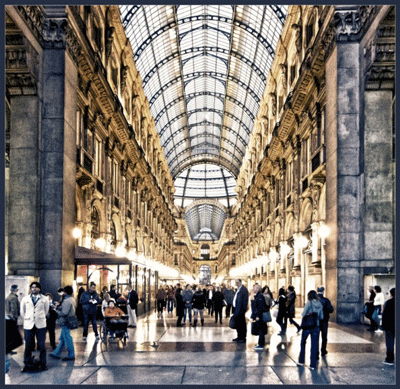
Shopping in Milan will suit everyone’s taste
While the highlight describe above give a measure of Milan’s attractiveness, there is indeed a lot more to it than this. Other wonderful places will delight IGARSS attendees, such as the original Sforza castle, built in 1368 and hosting 10 museum (works on display include Michelangelo’s Pietà Rondanini); Pinacoteca di Brera, one of the most important Italian art galleries; Teatro alla Scala, the famous opera house, designed by Piermarini, inaugurated in 1778. We warmly encourage you to attend IGARSS 2015 in Milan to combine science and leisure and have a wonderful experience.
Musei Nazionale della Scienza e della Tecnologia
Italy’s largest museum of science, the Museum of Science and Technology is housed in a 16th century monastery and houses over 10,000 items, including models of many of da Vinci’s drawings, Italy’s first submarine, and many interactive exhibits. This museum is where anyone of any age can find something to enjoy.
Museo del Novecento
The Museum of 20th Century Art housed in what used to be Mussolini’s Arengario, this multistory building that overlooks the Piazza del Duomo (Duomo Square) holds many great works of art. Any art or history lover will find that this museum can offer interesting look into Italy’s progression from Fascism through two world wars to the modern age through the eyes of artists that lived during that era.
Castello Sforzesco
Leonardo da Vinci is most remembered for his inspirational work in art and science, but many of the patrons that paid for his hobbies called on da Vinci to design implements of war, this castle is one such work that has lasted through time. Originally designed for the Visconti it later came under the possession of the Sforza dynasty, and even Napoleon saw its usefulness. Today the Castello Sforzesco houses seven museums showing Milan’s cultural history.



